Phonology Kazym Khanty
Introduction to Transliteration Tables for Kazym Khanty
A phoneme list is a collection of phonemes that are distinguished in a language. It also deals
with the correspondence of phoneme and grapheme. The phoneme lists have been created as
an interim step prior to the actual glossing work. Every publication which delivered a
transliterated text and originally edited in Russia received its own list.
Behind this step was the discovery that virtually every Russian author uses his or her
individual orthographical system. Partly, this system varies from publication to publication.
The origin of these differences lies in the fact that although a modified variant of the
Cyrillica (with additional characters) is used, there is no standardized binding orthography
for Khanty in particular.
For Western linguists or linguistically interested laymen these alleged small orthographical
differences together with the unfamiliar Cyrillic characters could constitute a serious
complication. Besides, all Khanty dictionaries are usually available in FUT (Finno-Ugric
Transcription), a highly specialized transcription. This means that firstly it could possibly be
difficult to identify a Kazym-Khanty word correctly. Secondly, especially for non-
Finnougrists it could be hard to recognize how to pronounce the word. Due to this, it was
necessary to provide a kind of tool in the form of phoneme lists and thus facilitating the
analysis of Kazym-Khanty texts to some extent.
In order to improve dealing with the phoneme lists the following procedure was adopted: To
simplify matters, it was decided not to place the phonemes between slashes (e.g. /a/). The
same applies to the graphemes, which have not been notated with the usual angle brackets
(f.e. <a>).
As a connective link the traditional FUT was given between the Cyrillic orthography and the
transcription in the International Phonetic Alphabet (IPA). This ensures that looking up
words in important dictionaries is possible further on. After an example word in both
Cyrillic orthography and IPA-transcription there is a page reference and a short comment
where necessary.
If a certain combination Cyrillica ~ IPA was supposed to exist but was not detected in
the selected pages of the book, this has been marked with the note “undocumented“.
Phoneme table including FUT, IPA and Cyrillic character correspondences
Phoneme tables including FUT, IPA, and Cyrillic character correspondences
(single publications)
Phoneme and transliteration tables, valid for:
Молданов, Т. А.: Кань кунш оӆаӈ. Выпуск 1. Ханты-Мансийск. 1997.
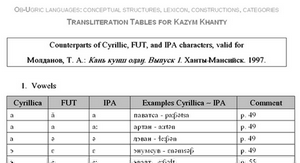
Молданов, Т. А.: Земля кошачьего локотка. Кань кунш оӆӑӈ. Выпуск 2. Томск: Издательство томского университета. 2001.

Молданов, Т. А.: Земля кошачьего локотка. Кань кунш оӆӑӈ. Выпуск 3. Томск: Издательство томского университета. 2003.
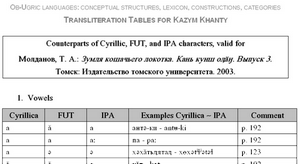
Молданов, Т. А.: Земля кошачьего локотка. Кань кунш оӆӑӈ. Выпуск 4. Томск: Издательство томского университета. 2004.
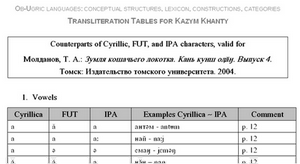
Молданов, Т. А.: Пелымский Торум – устроитель медвежьих игрищ. Ханты-Мансийск. 2010.
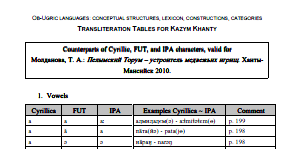
Пелымский Торум – устроитель медвежьих игрищ by T. A. Moldanova was published in 2010.
Regarding vowels it can be said that Moldanova uses <а> for the phonemes /aː/ and /a/
(open front unrounded vowel) and /ə/ (mid-central vowel, schwa). Parallel to this, she
utilizes <ă> for /ă/ as well. Another grapheme for /ə/ is <у>. Moldanova uses it if the schwa
preceds the bilabial consonants /p/, /m/, /t/. Besides, Moldanova transcribes /u/ (close back
rounded vowel) in the form of <у> or <ӱ>.
Moldanova uses three different graphemes for /eː/ and /e/. On the one hand, she uses <э>
for /eː/ and /ɛ/. On the other hand she writes <є> for /e/ und even for /ɛ/ as well.
Furthermore, one can also find
for /eː/ and /e/.
The phoneme /i/ (close front unrounded vowel) can be displayed by the two graphemes
<и> or <ы>. The latter often – but not always – appears in non-first syllables.
The main function of the following six graphemes is to indicate that the preceding consonant
is to be pronounced palatalized: <и>, <я>, <я̆>,<ю>, <ё>, <е>.
Here it must be noted that <и> (phoneme /i/) not always palatalizes the preceding
consonant. <я> stands for /ja/, /jaː/ (at the beginning of a word) and /ʲa/ und /ʲaː/
respectively as well as for /jɛ/ and /ʲɛ/, <я̆> for /ja/, /ʲa/, <ю> for /ju/, /ʲu/ and even /jo/,
/ʲo/, <ё> for /jɔː/, /ʲɔː/ and <е> for /je/, /ʲe/ and /jeː/, /ʲeː/ respectively. Analogous to the
phoneme /ə/ and its transcription as <а> or <у>, the graphemes <я> and <ю> are
used for /jə/ and /ʲə/ if /ə/ follows a palatalized consonant and precedes a bilabial consonant.
Moreover, Moldanova uses the grapheme <ə> for the phonemes /ɵ/ (close-mid central
rounded vowel) and /ʉ/ (close central rounded vowel). It must be noted here that /ɵ/ appears
only in first syllables and /ʉ/ only in non-first.
Нёмысова, Е. – Каюкова, Л.: Хантыйские загадки. На казымском и сургутском диалектах. Ханты-Мансийск: Полиграфист 2007.
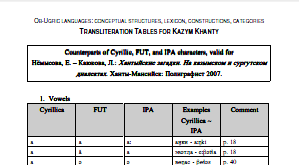 E. A. Nyomysova and L. N. Kajukova´s book Хантыйские загадки. На казымском и
сургутском диалектах was published in 2007 in Chanty-Mansijsk.
E. A. Nyomysova and L. N. Kajukova´s book Хантыйские загадки. На казымском и
сургутском диалектах was published in 2007 in Chanty-Mansijsk.
It deals with Kazym-Khanty and Surgut-Khanty riddles. The book is thus structurized that the Kazym-Khanty version of the riddle is on the left and the Surgut-Khanty version on the right. A
Russian translation of both versions is right below the riddles.
A monograph of quite similar content but with an English translation in addition was
already published in 2006 in St. Petersburg.
In the following only the orthography of the Kazym-Khanty riddles can be addressed.
Because it is still not clear whether there really is a schwa in the Khanty language or
whether it is rather an /a/ pronounced extremely short, Nyomysova/Kajukova, like many
other authors, use <a> for both /a/ (open front unrounded vowel) and /ə/ (mid-central
vowel, schwa). Moreover, they also use <ə> for /ə/, too, and there is even an example for
<i> for /ə/. Preceding bilabial consonants, the grapheme <у> is used for /ə/. In order to
indicate that the preceding consonant is to be pronounced palatalized, the authors utilize <ə̈>
/ʲə/.
The graphemes <а> and <ӑ> are both used for rendering the /a/ pronounced short.
Moreover, Nyomysova/Kajukova write two graphemes for the phoneme /e/ (close-mid front
unrounded vowel). <э> appears for /eː/ and /e/, whereas additionally represents /je/,
/ʲe/ and /jeː/, /ʲeː/. The grapheme <є> is used for /ɛ/ und /jɛ/. Interestingly, the authors
utilize <є̈> for /jɛ/ as well.
The phoneme /i/ (close front unrounded vowel) can be represented by means of two
graphemes <и> or <ы>. The latter often appears in non-first syllables.
The main function of the following seven graphemes is to indicate that the preceding
consonant is to be pronounced palatalized: <и>, <я>, <я̆>, <ю>, <ю̆>, <ё>,
<е>. Here it must be noted that <и> (phoneme /i/) does not always palatalize the preceding
consonant. <я> stands for /ja/, /jaː/ (at the beginning of a word) and /ʲa/ und /ʲaː/
respectively, <я̆> for /ja/, <ю> for /ju/, /ʲu/ and even /jo/, /ʲo/, <ю̆> for /ju/, /ʲu/, <ё>
for /jɔː/, /ʲɔː/ and <е> for /je/, /ʲe/ and /jeː/, /ʲeː/ respectively. It is interesting that the
phoneme /ə/ in analogy to its writing as <а> is not represented as <я> when following a
palatalized consonant and preceding a bilabial consonant. For /jə/ and /ʲə/ respectively the
already mentioned <ə̈> is used. The correspondence <у> ~ /ə/ has no equivalent here,
either: There is no grapheme <ю> for /jə/.
The grapheme <у> is also used for /u/ (close back rounded vowel) and even /o/ (close-mid
back rounded vowel). Furthermore, Nyomysova/Kajukova also write <ў> for /u/. The
grapheme stands for /ɔː/ (open-mid back rounded vowel).
Concerning the written reproduction of the phonemes /ɵ/ (close-mid central rounded vowel)
and /ʉ/ (close central rounded vowel), it can be said that the authors use <ɵ> for both
phonemes. It must be noted here that /ɵ/ appears only in first syllables and /ʉ/ only in non-first syllables.
The graphemes <ɵ̆> und <ɵ̈> indicate a palatalization /jɵ/. An equivalent /jʉ/ in a
non-first syllable could not be identified.
Соловар, В. Н.: Хантыйский язык. Учебник для 7-8 классов (казымский диалект). Ханты-Мансийск. 1995.
 Valentina Nikolaevna Solovar´s textbook Хантыйский язык. Учебник для 7-8 классов
(казымский диалект) was edited in 1995.
Valentina Nikolaevna Solovar´s textbook Хантыйский язык. Учебник для 7-8 классов
(казымский диалект) was edited in 1995.
Regarding vowels it can be said that Solovar uses both <а> and <ӑ> for the
phonemes /a/ (open front unrounded vowel) and /ə/ (mid-central vowel, schwa). Moreover,
she utilizes <ə> for /ə/ as well. This is because it is still not clear whether there really is
a schwa in the Khanty language or whether it is rather an /a/ pronounced extremely short.
Other graphemes for /ə/ are <у> or <ӱ>. Solovar uses them if the schwa precedes the
bilabial consonants /p/, /m/, /t/. In addition, Solovar transcribes /u/ (close back rounded vowel)
in the form of <у> or <ӱ>.
The phoneme /i/ (close front unrounded vowel) can be represented by the two graphemes <и>
or <ы>. The latter often – but not always – appears in non-first syllables.
The main function of the following five graphemes is to indicate that the preceding
consonant is to be pronounced palatalized: <и>, <я>, <ю>, <ё>, <е>.
Here it must be noted that <и> (phoneme /i/) does not always palatalize the preceding
consonant. <я> stands for /ja/, /jaː/ (at the beginning of a word) and /ʲa/ und /ʲaː/
respectively, <ю> for /ju/, /ʲu/ and even /jo/, /ʲo/, <ё> for /jɔː/, /ʲɔː/ and <е> for /je/, /ʲe/
and /jeː/, /ʲeː/ respectively. Analogous to the phoneme /ə/ and its transcription as <а> or
<у>, the graphemes <я> and <ю> are used for /jə/ and /ʲə/ if /ə/ follows a palatalized
consonant and preceds a bilabial consonant.
Moreover, Solovar uses the grapheme <ə> which can also be used for the schwa /ə/. Yet it
is more frequent that <ə> is used for the phonemes /ɵ/ (close-mid central rounded vowel)
and /ʉ/ (close central rounded vowel). It must be noted here that /ɵ/ appears only in first
syllables and /ʉ/ only in non-first syllables.
Хомляк, Л. Р.: Арєм-моньщєм еӆ ли мӑнӆ... Если моя песня-сказка дальше пойдёт... Ханты-Мансийск: Полиграфист 2002.
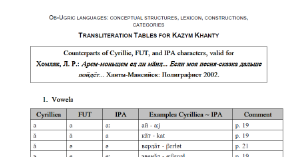 Арєм-моньщєм еӆ ли мӑнӆ... Если моя песня-сказка дальше пойдёт... was published in
2002 and contains narratives, tales and songs in the Khanty and Russian languages by Pelageja
A. Grishkina. Some of the texts are autobiographical, whereas others are traditional
narratives.
Арєм-моньщєм еӆ ли мӑнӆ... Если моя песня-сказка дальше пойдёт... was published in
2002 and contains narratives, tales and songs in the Khanty and Russian languages by Pelageja
A. Grishkina. Some of the texts are autobiographical, whereas others are traditional
narratives.
Because it is still not clear whether there really is a schwa in the Khanty language or
whether it is rather an /a/ pronounced extremely short, Chomljak, like many other authors,
uses <ӑ> for both /a/ (open front unrounded vowel) and /ə/ (mid-central vowel, schwa).
Moreover, she also uses <ə> for /ə/ as well. Preceding bilabial consonants, the grapheme
<у> is used for /ə/. <у> also stands for /o/. The close back rounded vowel /u/ is
transcribed as <ӱ>. In order to indicate that the preceding consonant is to be pronounced
palatalized, the authors utilize <я̆> and even <й> for /ʲə/.
Unlike most of the other authors, Chomljak utilizes <а> exclusively for the representation of /aː/.
Furthermore, Chomljak writes two graphemes for the phoneme /e/ (close-mid front
unrounded vowel). <э> appears for /eː/ whereas apart from /eː/ and /e/ additionally
represents /jeː/, /ʲeː/ and /ɛ/. The grapheme <є> is used for /ɛ/ und /jɛ/. Interestingly, the
authors utilize <є̈> for /jɛ/ as well.
The phoneme /i/ (close front unrounded vowel) can be represented by means of two
graphemes <и> or <ы>. The latter often appears in non-first syllables.
The main function of the following six graphemes is to indicate that the preceding consonant
is to be pronounced palatalized: <и>, <я>, <я̆>, <ю>, <ю̆>, <ё>, <е>.
Here it must be noted that <и> (phoneme /i/) does not always palatalize the preceding
consonant. <я> and <я̆> stand for /ja/ (at the beginning of a word) and /ʲa/ respectively,
<я̆> for /ja/, <ю> for /ju/, /ʲu/ and even /jo/, /ʲo/, <ю̆> for /ju/, /ʲu/, <ё> for /jɔː/, /ʲɔː/
and <е> for /jeː/ and /ʲeː/. Analogous to the phoneme /ə/ and its transcription as <ӑ> or
<у>, the graphemes <я̆> and <ю> are used for /jə/ and /ʲə/ if /ə/ follows a palatalized
consonant and precedes a bilabial consonant.
Moreover, Chomljak uses the grapheme <ə> for the phonemes /ɵ/ (close-mid central
rounded vowel) and /ʉ/ (close central rounded vowel). It must be noted here that /ɵ/ appears
only in first syllables and /ʉ/ only in non-first syllables.
Хăнты ясаң. Ханты-мансийской автономной округ-Югра газета. Суббота 12 декабрь 2009 оӆ. No. 50.

Phoneme tables including FUT, IPA, and Cyrillic character correspondences
(comparison of publications)
Phoneme and transliteration tables, valid for:
Молданов, Т. А.: Кань кунш оӆаӈ. Выпуск 1. Ханты-Мансийск 1997.
Молданов, Т. А.: Земля кошачьего локотка. Кань кунш оӆаӈ. Выпуск 2. Томск 2001.
Молданов, Т. А.: Земля кошачьего локотка. Кань кунш оӆаӈ. Выпуск 3. Томск 2003.
Молданов, Т. А.: Земля кошачьего локотка. Кань кунш оӆаӈ. Выпуск 4. Томск 2004.
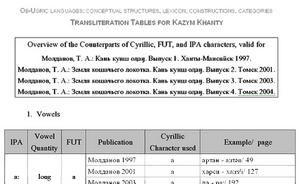
By means of this comparative phoneme list it becomes apparent that the notation of even
just one author definitely can change over the years.
Concretely, this list deals with the series
Кань кунш оӆаӈ by T. A. Moldanov, which was
edited in four volumes between 1997 and 2004. A fifth volume, which is not discussed here,
was published in 2011. The first three volumes deal with the mythological tales of the
Kazym-Khanty, whereas the fourth volume contains traditional bear songs.
Primarily there are differences when it comes to the written reproduction of vowels. Thus,
Moldanov uses throughout the entire series <a> for /aː/, /a/ (open front unrounded vowel)
as well as /ə/ (mid-central vowel, schwa). In the third and fourth volume he additionally uses
<ӑ>.
Another grapheme for /ə/ is <у>, which is also used for the phonemes /u/ (close back
rounded vowel) and even /o/ (close-mid back rounded vowel). Parallel to this, Moldanov
writes /u/ as <ӱ>.
The grapheme <э> appears in the first three volumes for /eː/ (close-mid front unrounded
vowel). In the first volume it additionally stands for /ɛ/ (open-mid front unrounded vowel) as
well. It does not appear anymore in the last volume. Instead, in volumes two to four Moldanov
utilizes <є> for /ɛ/ and in addition
. In all volumes the grapheme also stands
for /eː/, /e/ and the palatalizing /jeː/, /ʲeː/, /je/, /ʲe/. Moreover, in the fourth volume it is also
used for /jɛ/.
The phoneme /i/ (close front unrounded vowel) may be represented by means of the two
graphemes <и> or <ы>. The latter often appears in non-first syllables.
The main function of the following graphemes is to show that the preceding consonant is to
be pronounced palatalized: <и>, <я>, <я̆>, <ю>, <ё>.
Here it must be noted that <и> (phoneme /i/) does not always palatalize the preceding
consonant. <я> stands for /ja/, /jaː/ (at the beginning of a word) and /ʲa/ und /ʲaː/
respectively, <я̆> in volume two and four additionally for /ja/ and /ʲa/. <ю> is used for
/ju/, /ʲu/ and even /jo/, /ʲo/ and <ё> for /jɔː/, /ʲɔː/.
Moreover, in all volumes Moldanov uses the grapheme <ə> which should not be confused
with the phoneme /ə/. In fact, this grapheme is used for the phonemes /ɵ/ (close-mid central
rounded vowel) and /ʉ/ (close central rounded vowel). It must be noted here that /ɵ/ appears
only in first syllables and /ʉ/ only in non-first syllables.
Regarding consonants it must be noted that Moldanov transcribes the phoneme /sʲ/ (voiceless
alveolo-palatal sibilant) in volumes two to four in the form of <с> plus palatalizing vowel
(<и>, <я>, <я̆>, <ю>, <ё>). Among the various authors <щ> for /sʲ/ is actually
more common. This grapheme <щ> appears in Moldanov´s volumes one, three and four.
Additionally, <сь> appears in volume two, but this grapheme is mostly used by the
majority of authors only when transcribing Russian loanwords.
Молданов, Т. А.: Кань кунш оӆаӈ. Выпуск 1. Ханты-Мансийск 1997.
Молданов, Т. А.: Земля кошачьего локотка. Кань кунш оӆаӈ. Выпуск 2. Томск 2001.
Молданов, Т. А.: Земля кошачьего локотка. Кань кунш оӆаӈ. Выпуск 3. Томск 2003.
Молданов, Т. А.: Земля кошачьего локотка. Кань кунш оӆаӈ. Выпуск 4. Томск 2004.
Соловар, В. Н.: Хантыйский язык. Учебник для 7-8 классов (казымский диалект). Ханты-Мансийск 1995.







 Пелымский Торум – устроитель медвежьих игрищ by T. A. Moldanova was published in 2010.
Пелымский Торум – устроитель медвежьих игрищ by T. A. Moldanova was published in 2010. E. A. Nyomysova and L. N. Kajukova´s book Хантыйские загадки. На казымском и
сургутском диалектах was published in 2007 in Chanty-Mansijsk.
E. A. Nyomysova and L. N. Kajukova´s book Хантыйские загадки. На казымском и
сургутском диалектах was published in 2007 in Chanty-Mansijsk. Valentina Nikolaevna Solovar´s textbook Хантыйский язык. Учебник для 7-8 классов
(казымский диалект) was edited in 1995.
Valentina Nikolaevna Solovar´s textbook Хантыйский язык. Учебник для 7-8 классов
(казымский диалект) was edited in 1995. Арєм-моньщєм еӆ ли мӑнӆ... Если моя песня-сказка дальше пойдёт... was published in
2002 and contains narratives, tales and songs in the Khanty and Russian languages by Pelageja
A. Grishkina. Some of the texts are autobiographical, whereas others are traditional
narratives.
Арєм-моньщєм еӆ ли мӑнӆ... Если моя песня-сказка дальше пойдёт... was published in
2002 and contains narratives, tales and songs in the Khanty and Russian languages by Pelageja
A. Grishkina. Some of the texts are autobiographical, whereas others are traditional
narratives.
 By means of this comparative phoneme list it becomes apparent that the notation of even
just one author definitely can change over the years.
By means of this comparative phoneme list it becomes apparent that the notation of even
just one author definitely can change over the years.